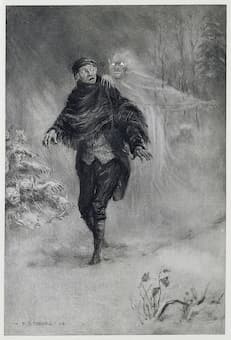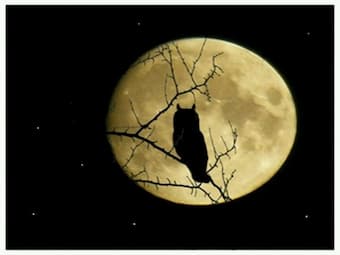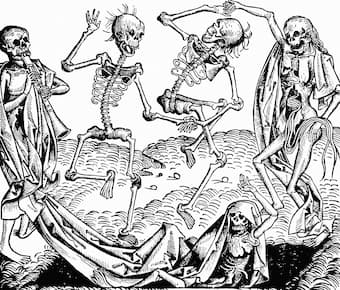
Coburn: Ichabod Crane, 1899
Whether you decide to venture out for the end of October holiday or stay home and just scare people with the music you’re playing, there’s a lot of scary music out there to chose from.
Opening with 12 strokes of the clock for midnight, it’s Saint-Saëns’ Danse macabre. The violin’s entry with brash tritones (the devil’s tones) makes it seem as though the devil has jumped right into our midst. Later in the piece, we have the introit Dies irae from the Requiem mass, but now given in a major key, and the xylophone imitating dancing skeletons, until the rooster’s crow for dawn comes and everyone returns to their grave.
Camille Saint-Saëns: Danse macabre, Op. 40 (Royal Scottish National Orchestra; Alexander Gibson, cond.)
Another work with dancing skeletons, this time played by the strings, comes from the climactic final movement of Berlioz’ drug dream Symphonie fantastique. Our hero imagines himself at a witches’ sabbath celebration, where ghosts and ghouls have gathered for his funeral (he was beheaded in the 4th movement). His beloved turns up, but now her melody is distorted and jumpy – a grotesque variation on what he loved. Bells chime, the Dies irae is played in the low brass and with a dry sound the skeletons dance.

Bernt Notke: Surmatants (Totentanz), St. Nicholas’ Church, Tallinn, end of 15th century (Art Museum of Estonia)
Hector Berlioz: Symphonie fantastique, Op. 14 – V. Dream of a Witches’ Sabbath (Stuttgart Radio Symphony Orchestra; Roger Norrington, cond.)
To really get your goosebumps going, try Henry Cowell’s The Banshee, named after the Irish spirit who appears to signal the approach of death. In Cowell’s hands, the banshee becomes a spirit of the piano. It requires 2 players, one at the keyboard to hold down the pedals and one who plays the inside of the piano, plucking and rubbing the resonant strings.
Henry Cowell: The Banshee

Owl silhouetted by the moon
Part of a series of occasional pieces composer Stephen Montague writes for his friends, A Crippled Ghost at Halloween has all the elements we want for a piece for a dark and scary night. His collection Autumn Leaves not only includes our Crippled Ghost (with a hoot owl’s appearance at the end) but also a Headless Horseman, from the story of Ichabod Crane, with its attendant cracks of lightning.
Stephen Montague: Autumn Leaves: A Crippled Ghost a Halloween (Philip Mead, piano; Stephen Montague, tape)

John Quidor: The Headless Horseman Pursuing Ichabod Crane, 1858
Stephen Montague: Autumn Leaves: Headless Horseman (Philip Mead, piano; Stephen Montague, tape)
American composer Peter Schickele exploits the sound of brass to give us a sharp and pointed Halloween, all done over a brisk rendition of the Dies irae, sometimes in canon.
Peter Schickele: Brass Calendar: X. October: Halloween (Custom Brass Quintet)
Band composer Alfred Reed gives us a rather jazzy Halloween Hobgoblin.
Alfred Reed: Suite No. 6 – III. Halloween Hobgoblin (Otonowa Wind Symphonica; Alfred Reed, cond.)

The Dance of Death from Liber Chronicarum, 1493
Now that you’re familiar with the Dies irae, hear Liszt’s take on it in his Totentanz (Dance of the Dead). Liszt had a long fascination with death, dating from his childhood and it continued through the end of his life. A 15th century book, the Chronicle of Nuremberg, included this illustration of death’s dance, with one skeleton playing a shawm.
Franz Liszt: Totentanz, S126/R457 – No. 2. Paraphrase on Dies irae (arr. M. Rosenboom and Chie Tsuyuki for piano 4 hands (Duo Tsuyuki and Rosenboom)
Then there’s Chopin’s final statement on death marches – this from his second piano sonata.
Frédéric Chopin: Marche funebre from Piano Sonata No. 2 in B-Flat Minor, Op. 35 (orch. Breiner) (Razumovsky Sinfonia; Alfred Eschwé, cond.)
Julia Wolf’s explosion of sound is, indeed, Big Beautiful Dark and Scary!
Julia Wolfe: Big Beautiful Dark and Scary (Bang on a Can All-Stars)
Scare your neighbours or scare yourself – Happy Halloween!
For more of the best in classical music, sign up to our E-Newsletter




